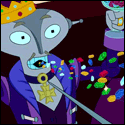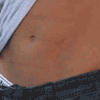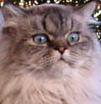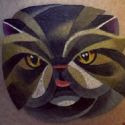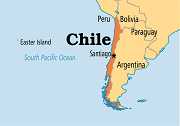|
Mr. Fedora posted:I just borrowed Drawing the Head and Hand by Andrew Loomis from my local library, and I'm not entirely certain on how to learn from it. The written sections recommend drawing some of the plates, but seem to say that others are just for reference. You might be worrying a bit too much here. Any of the things you described above would be fine things to do. There really isn't one set way to approach this. One thing I'd stress though is don't feel like you have to "master" what's on a page before moving on to the next. Fundamental study is life long kind of thing that you'll always wanting to be improving at and it's hard. You gotta give stuff time to click in and usually that means repeated studies from multiple sources, lots of practice, etc. So just work with the book at whatever pace you feel comfortable with. If you want to jump around, then jump around. If you want to work meticulously page by page because that's your mindset then do that. Just work in a way that feels natural to you and is something you'll be able to keep up. Worst thing would be to all gung ho and drive yourself crazy for a week or two, then drop the book and never pick it up again. Every time you go through a book like that, or do a master study, still life, or whatever, you'll learn a little more. So if you do it a lot over time, it'll all add up. Just read some stuff, copy some stuff, and try to apply the lessons you learned to some new stuff in whatever fashion you like.
|
|
|
|

|
| # ? May 5, 2024 07:34 |
|
JuniperCake posted:Good Advice Thanks, that's really helpful! I defs have a tendency to overthink this stuff.
|
|
|
|
There's an idea that's been rolling around in my head for about a week now, and I'm wondering if people will find it useful and usable. I could post the syllabus from each of the art classes I took, with an outline of each assignment. This would include both in-class and homework, with the expected hours spent on each item. It wouldn't be a copy paste straight from the syllabus PDF, that would literally be plagiarism or something, and I think I can explain it better anyway. The way I imagine the thread would be used is this: You can do each assignment in order, and post your result. I couldn't possibly handle critique or grading myself, and there are other artists with more expertise in those areas to provide feedback (in painting, drawing, and digital applications). To make sure things get "graded" in a timely manner, I think assignments should be either open to critique from anyone, or by posters who have already completed the assignment. However, I want critiques to be alterations of images posted for feedback. Meaning: If it's an image, the poster providing the critique has altered the image to show their advice, in addition to a typed explanation of those changes. If it's a file such as photoshop, painter, maya, or illustrator, the critique involves manipulations of those files. The thread structure can get messy, as well as the threads themselves. I think these threads should have their own subforum, a stickied thread for each syllabus, and a thread for each assignment. The assignment threads would move a lot (hopefully), so the stickied syllabus threads would need to be the directory used to navigate to each assignment's thread. There's also a technical support element to this, and I think those questions should be consolidated in the syllabus threads. Assignment threads would be for assignment post, critique, and discussion only. If it strikes you as extra work for mods, I would love to manage such a subforum if you let me. In the meantime if you want to see a proof of concept first, I think it could work with just a subforum and my basic membership abilities, and sticky support for the syllabus threads.
|
|
|
|
I'm not sure if these forums as a whole really have the traffic or the collective discipline that something like that would demand.
|
|
|
|
mutata posted:I'm not sure if these forums as a whole really have the traffic or the collective discipline that something like that would demand. Nowhere NEAR enough traffic, imo. I have tried similar things on other forums before, and people don't like that level of commitment.
|
|
|
|
 It's been about two years since I first picked up drawing. Something like this would've been unthinkable for me to even start on two years ago. A wacky series of medical complications laid me low in that time, but doing even this simple art gives me tremendous pleasure and a drive to keep going strong. Without much better to do, I'm angling to try to turn this into a real career. Getting to this point isn't something I could've done alone; this thread was my big jumping-off point. A big ol' New Years thanks to everyone for constant advice and recommendations. Hope y'all keep your art going!
|
|
|
|
Not trying to be a jerk, but what kind of art career are you thinking of pursuing? Selling drawings/paintings?
|
|
|
|
Ccs posted:Not trying to be a jerk, but what kind of art career are you thinking of pursuing? Selling drawings/paintings? Portraiture and paintings, along with commissions, with possibly something further down the road. It's mostly going to be supplementary for the moment; I haven't got starry eyes about my prospects, but I'd like to give 'er a go nonetheless. I was diagnosed with fibromyalgia late last year, and my health's kinda gone in the shitter. I was previously angling towards something more word-related, but I'm struggling post-illness with reading and writing (I can get maybe an hour in before I've got to go lie down, and I'm having trouble with mental processing - especially things that involve logical chains - a lot of the time). I've mostly just been looking for something that I can actually do consistently, and I've found that spatial, creative work (like drawing) doesn't cause me nearly as much trouble. Vermain fucked around with this message at 18:07 on Jan 1, 2016 |
|
|
|
I'm going to finish "You Can Draw in 30 Days" by Mark Kistler by the end of the week, and I could use some recommendations for what book I should buy next. I want to stick with pencil drawing, and I'd like to improve in the areas of perspective drawing, figure drawing, contouring, etc., but I don't want to move onto something that only covers a single specific topic.
|
|
|
|
Got a pack of Prismacolor after seeing they were 60% off. How do I color pencil correctly ? I see a lot of books on Amazon about colored pencil, any recommendations?>
goodness fucked around with this message at 02:08 on Feb 16, 2016 |
|
|
|
Many layers.
|
|
|
|
Any good suggestions for books about modern art history? My curiosity was really piqued by McCloud's explanation of the history of abstraction in "Understanding Comics" and I want to read more about it (not just in a comics context).
|
|
|
|
I always recommend the all-encompassing Story of Art, and have also enjoyed How to Read Contemporary Art and What Are You Looking At?: The Surprising, Shocking, and Sometimes Strange Story of 150 Years of Modern Art. Hope this helps!
|
|
|
|
regularizer posted:I'm going to finish "You Can Draw in 30 Days" by Mark Kistler by the end of the week, and I could use some recommendations for what book I should buy next. I want to stick with pencil drawing, and I'd like to improve in the areas of perspective drawing, figure drawing, contouring, etc., but I don't want to move onto something that only covers a single specific topic. I bought "Figure Drawing For All It's Worth" by Andrew Loomis, but it's a bit more advanced than what I'm capable of. Is there a good introductory book or online resource for figure drawing?
|
|
|
|
Are you drawing the figure from life?
|
|
|
|
Franchescanado posted:I always recommend the all-encompassing Story of Art, and have also enjoyed How to Read Contemporary Art and What Are You Looking At?: The Surprising, Shocking, and Sometimes Strange Story of 150 Years of Modern Art. Exactly what I was looking for, thanks!
|
|
|
|
regularizer posted:I bought "Figure Drawing For All It's Worth" by Andrew Loomis, but it's a bit more advanced than what I'm capable of. Is there a good introductory book or online resource for figure drawing? I know I'm starting to sound like a broken record, but I really cannot recommend Stan Prokopenko's video series enough when it comes to figure drawing. You'll want to look at and fully grasp his drawing basics series (although the materials aren't quite as important; I started learning how to draw with a pink eraser left over from high school and a spooky Halloween #2 pencil), as understanding three-dimensional forms and being able to draw them intuitively on a two-dimensional surface is key to good figure drawing. As neonnoodle said, try your best to ensure that you learn from live drawing as much as possible, as this will help to hone your skill at turning 3D into 2D. Since a photograph is already 2D, it can become very tempting to simply copy lines as you see them, rather than grasping the underlying structure of the figure. If you do use photographs to practice from, try to make sure that they come from someone like Stan who has their shots adjusted to downplay the various quiddities of photography (the distortion of a camera lens being one of the big ones) so that your analysis of the figure will be more accurate.
|
|
|
|
Awesome, I'll check it out. Thanks!
|
|
|
|
I hope this isn't the wrong place to ask this, but I've been taking a class where we have to work in acrylic. It's the second acrylic class I've taken, but I'm still kind of at a loss as to what to do about this. In almost all of my brush strokes, the paint kind of clumps together, and I can't seem to get smooth lines at all. In addition to that, the paint dries on my palette incredibly fast, so the problem on gets worse as time goes on. I've tried using water, but the opacity always seems a little low, or sometimes the water just dilutes the paint altogether. Here's a painting I did earlier today so you can see what I mean: The edges aren't the only problem with the painting, but it's the only problem that I feel like stems from me struggling with the medium itself and not just with general art concepts like color and trying to mix the color to what I want to be (though oil was easier for that too, since it would stay wet and I could mix it on the canvas).  I did this oil painting last year. It has its own edge problems and it's bigger, but they're still much less severe than the acrylic ones. I'd like to think that I've improved since then, but seeing those two side by side, it really doesn't look that way. Am I on the right track with the water thing? Do I need to have more paint on my brush? What should I be doing?
|
|
|
|
Your oil painting looks pretty good, so I agree with you that it looks like you're having problems with the paint itself more than anything else. Acrylics are weird and frustrating. Here are some tips:
|
|
|
|
Chiming in to second the keep your bristles damp. You shouldn't leave brushes immersed in water though, it kills the life of your brushes. Water will get up into the ferrule and weaken the glue that holds them together. Additionally don't leave your brushes standing on their bristles you'll deform the bristle shape and it'll apply paint poorly/ununiformly. Acrylic paint dries exceedingly fast, so you have to work quickly and really know what you're going to be doing. Using a retarder helps a bit, extending the open time of the paint on the pallet, you'll want to thoroughly mix your mediums with the paint so it has an even consistency and clump it up to eliminate drying on the palette as much as possible. Really the name of the game is layering and scumbling to cheat a blended appearance. Blending is possible but pretty difficult. Lots and lots of practice are really what you'll need.
|
|
|
|
Thanks for the advice! I got some retarder earlier and tried it out. I tried it out, and I think I probably need to use more than I did and do a better job keeping the brush wet. I got lazy painting some vertical blinds in the back and overshaded some areas in the front, but I think my color relationships are getting better.
|
|
|
|
It's a bit difficult to see what's going on here, but Since it looks like you're painting on paper that'll make the paint more difficult to work with since it's a super absorbent surface. With retarder you don't really need to use much, about 1 part to 8 parts paint for thicker applications. My personal mix when I use acrylics is: Appropriate sized glob of paint, ~1/8 amount of retarder, and ~1/3 amount acrylic medium. I'll also add a drop of flow release, despite being told by the instructions to not use it as a medium, but I like to live dangerously. Really though, you shouldn't be mixing paint on the canvas, unless you mean you're blending the colors together for a seamless transition. It's possible with acrylics, but super difficult since it dries so fast. Oils and acrylics require totally different approaches to painting despite seeming similar. Acrylic paints start forming a film or "skin" generally within 10 minutes or so. It's an exercise in frustration trying to treat them like oils since they don't behave the same. The nice thing about the fast drying time is that you can layer super easily. The acrylic picture several posts up already has that happening, it just needs more layers to bring out a similar effect as your oil painting. You can cheat a blended appearance by scumbling. This isn't the greatest tutorial and a lot of what the dude says is dumb, but it shows the effect pretty clearly. https://www.youtube.com/watch?v=C-Ft67tFCYg Here's a picture of a painting I did with acrylics, specifically the body of the pig was shaded with lots and lots of layers, pulling the shadow and light areas together until they appeared relatively seamless. I did also blend the colors in the wings and the eyes, but the painting is pretty small (12"x16") so they were pretty small areas to blend.  What sort of brushes are you using, like type and size? My personal choices are Filberts, rounds, flats, and several "grainers". Also, are you doing any underpainting or sketches beforehand or just throwing paint on to the surface? A sketch or underpainting aren't necessary, but are super helpful to get general guidelines of what you're painting. Painting is a very time intensive, and rewarding process once you figure out what you're doing. That small painting above was done in a solid 13 hour stretch of painting since I needed to get it done...but the point is that it takes hours and hours of work to fully flesh out or develop a painting.
|
|
|
|
Yeah, sorry, I couldn't get a good photo of that particular painting. In my class what we've been doing is working on paper and without sketches, so for my paintings at home I've been trying to practice that. The idea I think is just being able to work quickly, and do a lot more paintings in the course of the semester compared to the class I took last year. I"ll have to look into scumbling, thanks. I've been using a 1" flat brush and a round brush, but I don't remember the size on it. I have some larger brushes for my larger paintings, but they aren't as nice.
|
|
|
|
A 1" flat is a huge brush, really only suitable for larger areas. A variety of smaller brushes will help you get the finer details I feel like you're looking for. You can get by with just flats and rounds, I'd say that a 6 round and a 2 round would be good, then around the same for flats. Trying to do fine details with a giant brush is just going to frustrate you endlessly. Princeton makes some decent cheapish brushes, I forget the line that they call them, but they have blue handles and kinda orange bristles. Really though, go to the art supply store and gently caress around with the brushes to see what you like, try to find brushes with good a bristle density so it'll hold paint well and you won't be having to reload the brush constantly. Bristle springiness is really your preference, I like a reasonably soft bristle with a solid spring to it... It's difficult to describe but the bristles flex pretty easily, but return to their original shape quickly and easily.
|
|
|
|
I need some advice on how to get a Hi resolution copy of a canvas I have. It is 18"x30" I think. Need a great digital copy to do some digital manipulation. Is it possible to get it scanned at an office store or printing place?
|
|
|
|
goodness posted:I need some advice on how to get a Hi resolution copy of a canvas I have. It is 18"x30" I think. Need a great digital copy to do some digital manipulation. Is it possible to get it scanned at an office store or printing place? You might be thinking professional photograph at that size
|
|
|
|
goodness posted:I need some advice on how to get a Hi resolution copy of a canvas I have. It is 18"x30" I think. Need a great digital copy to do some digital manipulation. Is it possible to get it scanned at an office store or printing place? I try to scan when I can. I've scanned a 5'x4' painting at FedEx Kinkos. Office service places have very big scanners, but to use them you will need to take the canvas off the frame. It has to feed through a large format scanner which works like a giant hand wringer, with two rollers. Also, if it's black and white you'll have an easy time adjusting the colors. If it's in color, you'll at least know what tint light is used by a scanner. If you use photography, you'll have some size distortion from the center of the image outward. You'll also have to guess at the lighting, and there will probably be a sheen on the surface. You're also liable to get shadows in the texture of the media.
|
|
|
|
frozenpussy posted:I try to scan when I can. I've scanned a 5'x4' painting at FedEx Kinkos. Here is the painting, it is a lot of color so I think scanning would be the best option. Hopefully the artist got a scan of it that I can ask. 
|
|
|
|
Hi, Hi! I hope this is the right thread for this. I've been drawing in my spare time for the past 2 years now, and I think I've gotten to the point where I'm not immediately embarrassed bvy what I've drawn so I decided to get some criticism for my more recent stuff.  This is my most recent sketch, it took me about 20-30 minutes. Any ideas on how I can improve on technique/what resources could help me?
|
|
|
|
Observational drawing, which is to say you need to relearn how to see the world around you. Your drawing shows that you are drawing symbols and what your brain thinks a person looks like as opposed to what is actually real. We all start out this way! I recommend the book "Drawing on the Right Side of the Brain" (as do many). It will explain this concept and has lots of exercises to help you learn how to practice it.
|
|
|
|
mutata posted:Observational drawing, which is to say you need to relearn how to see the world around you. One other thing related to this, don't be afraid to use other art to improve your drawing. I revisited photography to learn how to draw better, because it forces you to pay attention to people and environments a lot more closely in reality. Plus, since the photos are mine, I have a bit more attachment/motivation into seeing my sketches turn out well.
|
|
|
|
Don't draw on lined paper.
|
|
|
|
devilmaydry posted:This is my most recent sketch, it took me about 20-30 minutes. Any ideas on how I can improve on technique/what resources could help me? As for references, a really basic introduction to drawing fundamentals I like is the book The Art of Drawing by Willy Pogany.
|
|
|
|
Fangz posted:Don't draw on lined paper. who cares, draw on anything you want. paper is like the least important part in the learning process
|
|
|
|
a hole-y ghost posted:you need to get a good feel for rendering objects in a 3 dimensional space. Basically just draw a lot of big pages (at least 24"x18") totally full of cubes at different angles. This way you see them all on the page and keep trying until they look right (I say use a big page and fill it up because as you're drawing you can still see all the good and bad ones you made). Also, lots of big pages of circles, and lines. I'll second this. "Drawing" really refers merely to the ability to create three-dimensional form on a 2D surface (like a piece of paper or a computer screen). Once you learn how to do that and get an intuitive grasp of it, you've learned how to draw. Everything else past that point is just "knowledge": understanding the volume of an object in order to draw it accurately on paper. It sounds odd, but there's a certain point you'll eventually hit if you do this where you can begin to "feel" the three-dimensionality of objects as you draw them. Even if I'm not drawing something that's exactly shaped like a cube or a cylinder, I can visualize the rough volume of it with the use of things like contour lines. Ideally, you should be able to draw boxes, spheres, and cylinders from any angle. Challenge yourself to fill an entire sheet with boxes that are all at completely different angles. I recommend, of course, Stan Prokopenko's video on this, as well as the other videos he has on his page. Start out by using a horizon guide for drawing the boxes, and then start trying to draw them purely based on instinct. Futaba Anzu posted:who cares, draw on anything you want. paper is like the least important part in the learning process The only reason I would advise to not draw on lined paper is because it can make practicing confusing, since the intersecting lines muddy the drawing and can make it challenging to discern if it really looks "correct" or not. There's no need to go and purchase expensive Moleskines or whatnot, but you can go to any local arts and crafts store (or even big box office supply stores) and pick up giant pads of cheap newssheet for a couple of bucks easily. edit: i for sure know what a moleskine is and i'm not an idiot Vermain fucked around with this message at 21:27 on Apr 13, 2016 |
|
|
|
Futaba Anzu posted:who cares, draw on anything you want. paper is like the least important part in the learning process  a hole-y ghost posted:As for references, a really basic introduction to drawing fundamentals I like is the book The Art of Drawing by Willy Pogany. Another good one is The Practice & Science of Drawing by Harold Speed. It's in the public domain. There are some fantastic skills to be gained from studying that book alone.
|
|
|
|
It should be noted that drawing from imagination is something that I've found to come naturally out of simply grasping three-dimensional form when drawing and then gaining sufficient knowledge about a subject to be able to visualize its 3D elements. There's a lot of helpful guidelines out there, like the proportions of the head/body/etc., but you need to ensure that you have a fundamental grasp of volume first or else you'll find yourself struggling a lot with things seeming "off" about your drawings (like I used to, and still sometimes do).
|
|
|
|
Vermain posted:It should be noted that drawing from imagination is something that I've found to come naturally out of simply grasping three-dimensional form when drawing and then gaining sufficient knowledge about a subject to be able to visualize its 3D elements. There's a lot of helpful guidelines out there, like the proportions of the head/body/etc., but you need to ensure that you have a fundamental grasp of volume first or else you'll find yourself struggling a lot with things seeming "off" about your drawings (like I used to, and still sometimes do). This was the order in which I learned and I concur, for whatever that's worth. It instills a healthy respect for research and reference even in your more imagination-driven projects as well.
|
|
|
|

|
| # ? May 5, 2024 07:34 |
|
Vermain posted:It should be noted that drawing from imagination is something that I've found to come naturally out of simply grasping three-dimensional form when drawing and then gaining sufficient knowledge about a subject to be able to visualize its 3D elements. There's a lot of helpful guidelines out there, like the proportions of the head/body/etc., but you need to ensure that you have a fundamental grasp of volume first or else you'll find yourself struggling a lot with things seeming "off" about your drawings (like I used to, and still sometimes do). Yeah, absolutely this. Focusing on cubes and other simple 3D objects as Ghost said is an excellent exercise too. If you get a good handle on form, you can draw just about anything by breaking them down into simple objects like spheres, cubes, cylinders,etc. Printer/Copy paper can be pretty cheap and a decent drawing material if you don't want to go to an art store too.
|
|
|



